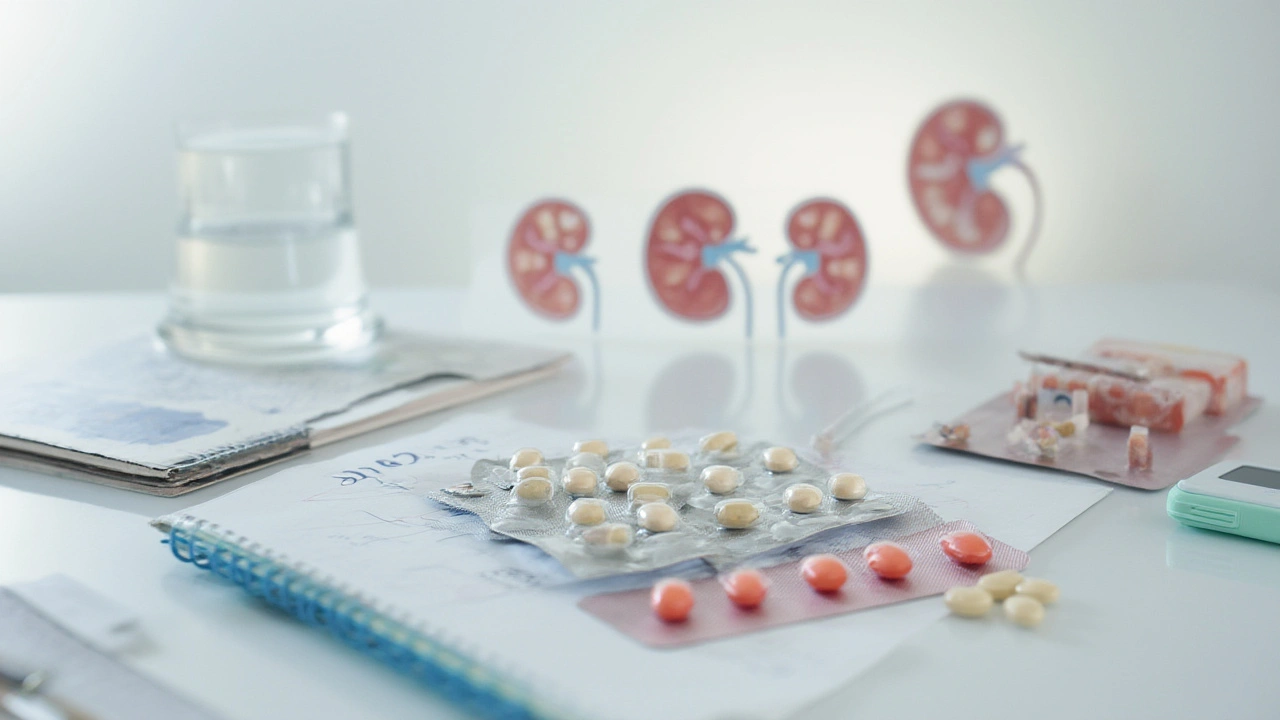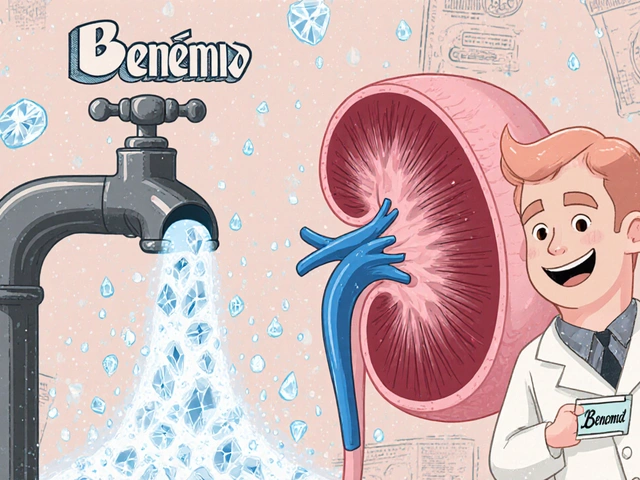Imagine having your body treat your new kidney or liver like an unwanted guest. That's the nightmare many transplant patients face, thanks to a hyperactive immune system. Neoral, a brand name for cyclosporine, acts like a peacekeeper—quieting the defenses just enough to let life-saving organs settle in without a brawl. But this medication is not just about transplants. It's got a surprising range, coming to the rescue in some severe skin and autoimmune conditions. If you've ever wondered what it really does, why doctors trust it, or what pitfalls might come along with it, you're in the right place.
What Is Neoral and How Does It Work?
Neoral is actually a reformulated version of cyclosporine, a strong immunosuppressant. When you swallow a Neoral capsule, it heads into your bloodstream and gets to work suppressing parts of the immune system—especially the T-cells. Why target T-cells? Well, they're the big bosses in immune responses, calling the shots for attacks on anything that looks foreign. That’s awesome when you’re fighting a virus, but disastrous when you’ve just received a donated organ. The active ingredient, cyclosporine, basically slams the brakes on T-cell action, reducing the risk of organ rejection after a kidney, liver, or heart transplant. Doctors also use Neoral to treat autoimmune diseases like severe psoriasis and rheumatoid arthritis, calming inflammation that just won’t quit.
Here's something a lot of people miss: Neoral isn't a generic cyclosporine. The formulation improves how your body absorbs it, leading to steadier blood levels and (hopefully) fewer dangerous peaks and valleys. Capsules come in doses like 25 mg and 100 mg, and there’s also a liquid solution for people who can’t swallow pills. The dosing is usually based on body weight and constantly tweaked based on blood levels and lab tests. Don't expect a cookie-cutter prescription here—doctors tinker a lot to get it just right.
Let’s look at the major conditions Neoral targets:
- Organ transplantation: Prevents rejection of kidneys, livers, and hearts after surgery.
- Severe psoriasis: Used when topical treatments flop and the disease gets out of control.
- Rheumatoid arthritis: For cases where usual drugs aren’t enough.
There’s a technical tweak too. Neoral and the old Sandimmune have different absorption rates, so you can’t swap them one-for-one. That change actually helped a lot—before Neoral, managing cyclosporine levels felt like flying in the dark.
Who Needs Neoral? Typical Patients and Reasons for Use
Organ transplant recipients—people who just got a new kidney, heart, or liver—are the group most likely to have Neoral written on their prescription bottles. For them, it’s literally a life-saver. The immune system doesn’t care if that new liver means the difference between living and not. To the body, it’s a foreign invader, and the T-cells rally for an attack. Without drugs like Neoral, rejection rates would skyrocket.
The other big group includes people with severe autoimmune diseases. Take psoriasis for instance—when patches get so inflamed and raw that normal creams and light therapy don’t help, Neoral can transform daily life. It’s not the first drug doctors reach for, but for folks who’ve cycled through everything else, it’s a serious contender. Severe rheumatoid arthritis sits in the same club. When joints are swelling and stiffening despite all standard treatments, Neoral may be the next step.
While those are the main uses, there’s a tiny slice of cases where doctors try Neoral off-label in rare immune disorders or to delay certain symptoms in chronic conditions. But that’s not the norm and typically happens at specialty clinics.
Speaking of rare, cyclosporine therapy is a balancing act. Take too little and the immune system wakes up, attacking the new organ or body tissues. Take too much and you leave yourself wide open to infections or kidney damage, not to mention a dozen other side effects. That’s why those on Neoral often become pros at remembering lab checkups and bloodwork. If you’re squeamish about needles, it’s worth knowing upfront—regular monitoring is non-negotiable.
The age range is wider than you might think. In pediatrics, Neoral is sometimes used for children with rare kidney diseases like nephrotic syndrome when nothing else works. Elderly patients might also be prescribed Neoral after a transplant, but doctors weigh the risks even more carefully because older kidneys are already fighting an uphill battle.

Benefits, Facts, and Interesting Insights About Neoral
One of the most impressive facts? The introduction of Neoral in the 1990s made transplants dramatically safer. Before cyclosporine came along, survival rates after a heart transplant barely crawled past 50% in the first year. Thanks to Neoral and similar drugs, that number jumped over 80% by the early 2000s. The real-world impact is hard to overstate—thousands of lives every year made possible by a single capsule.
For people with brutal psoriasis, Neoral can mean the difference between hiding at home and living a normal life. Studies show some patients have their skin clear by upwards of 75% within just two months. But here’s the twist: it’s not a long-term fix for most. The risks pile up over time, so doctors use it more like a rescue option rather than a forever prescription.
Neoral comes with some clever patient tips too:
- Take it at the same time each day—with or without food, but avoid grapefruit or grapefruit juice. Grapefruit can boost cyclosporine levels way higher than intended, raising the risk of side effects.
- Tightly stick to the dose. Skipping or doubling up is a huge no-go.
- If you’re planning vaccines or dental procedures, tell your doctor. Immune-suppressing drugs mess with how you react to infections and shots.
- Keep a log of your symptoms and side effects—having notes at every appointment saves time and helps catch problems early.
It’s not all dry numbers and facts either. The birth of Neoral was a pharmaceutical innovation—a microemulsion delivery system that made the active drug steady and reliable. For patients, this meant fewer wild swings in drug levels, which was a massive frustration with the older version of cyclosporine. By the late 1990s, Neoral became the new standard for many who needed immune suppression.
Here’s a quick table with typical uses and response rates from real-world studies:
| Condition | Average Response Rate | Time to Effect |
|---|---|---|
| Kidney Transplant | 80–90% success over 1 year | Immediate, ongoing |
| Heart Transplant | 75–85% success over 1 year | Immediate, ongoing |
| Severe Psoriasis | 60–85% major improvement | 4–8 weeks |
| Rheumatoid Arthritis | 45–65% moderate improvement | 4–12 weeks |
Risks, Side Effects, and What to Watch Out For
If there’s one downside to Neoral, it’s the packed list of potential side effects. This isn’t a Tylenol-level drug. Even at the right dose, cyclosporine can wear down the kidneys over months and years. Doctors keep a close eye on blood pressure and kidney function, because a dose that’s safe now might cause trouble later.
The most common side effects include:
- High blood pressure
- Tremors or shaking hands (often called cyclosporine handshakes!)
- Gum swelling—dentists recognize cyclosporine patients by their puffy gums
- Increased hair growth (sometimes a surprise for female patients)
- Headache
- Upset stomach or diarrhea
But the more serious risks include kidney injury, increased chance of infections, and (rarely) an elevated risk of certain cancers after years of use. Why? Because a quieted immune system doesn’t spot and fix trouble as quickly. Here’s what one respected medical reference, the Mayo Clinic, says about cyclosporine:
"Careful and frequent monitoring is needed to make sure you’re getting enough of the medication to prevent rejection without tipping into dangerous side effects. Never adjust your dose on your own."
There are also food and drug interactions to watch for. Grapefruit is the big one—skip the juice during your therapy. Some antibiotics, antifungals, and anti-seizure medicines either spike or drop cyclosporine blood levels, and even over-the-counter supplements can mess things up. Always clear new meds with your prescribing doctor.
Bloodwork is a major part of life on Neoral. Lab tests typically check:
- Blood cyclosporine level (to see if you’re in the sweet spot)
- Kidney function (creatinine, BUN)
- Liver enzymes
- Blood pressure and cholesterol
Urine tests and even random dental exams sometimes sneak onto the monitoring checklist, since swollen gums and protein in the urine can signal trouble. The frequency of checkups is usually highest right after starting and tapers off if things stay stable. But you never really get away from blood draws entirely.

Practical Tips for Managing Life With Neoral
Staying on Neoral is a bit like juggling—meds, doctors, routine checks, and remembering all the random food rules. But people make it work, especially with a few tried-and-true habits:
- Set alarms or reminders for your dose. Most side effects creep in when people miss or double-up on pills.
- Keep a "meds kit" with your Neoral, list of current meds, and a snack you can take it with—super handy if you travel a lot.
- If you feel sick—fever, weird bruises, odd swelling—call your doc right away. Infections move faster under immune suppression.
- Dental hygiene gets even more important. Swollen gums are common, but brushing and flossing help a lot. Tell your dentist you’re on Neoral before any work.
- Protect your skin. Immune-suppressant meds make you a bit more sun-sensitive. Slather on sunscreen and wear a hat if you’re outdoors for long.
If blood pressure creeps up, don’t be surprised if your doc adds another pill to the mix—that’s incredibly common. Staying active and choosing low-salt groceries helps keep numbers in check too.
People often swap stories about taste changes and odd cravings. Some folks notice changes in how food tastes after starting Neoral, but usually this fades or becomes background noise.
And here’s something real: Neoral isn’t a forever drug for most non-transplant patients. For psoriasis and rheumatoid arthritis, doctors use it until your condition is under control, then slowly wean you off if possible. That’s to limit the risks from long-term use. If you’re a transplant patient, you’ll probably stay on some form of cyclosporine, but the dose might slowly drop over time if everything looks great on your labs.
Living with Neoral can feel like having a new normal, but thousands of transplant recipients and autoimmune warriors pull it off every day—thanks to vigilant monitoring and good routines. So while it’s not an easy ride, it’s a path to better health for people who need it most.







Write a comment
Your email address will be restricted to us